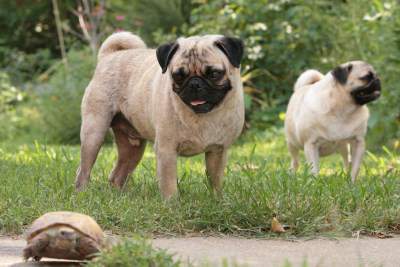Scared Pug

Pugs that are Afraid or Nervous
Overview
We are first going to answer a reader's specific question about her Pug that acts quite scared of just about everything. Then, we'll dive into some great tips to help you teach a Pug to feel more confident.
Question: My Pug is 5 months old and she is one scared and afraid a lot of the time. She is afraid of many things. This is especially evident when I take her out for a walk.
I stay in an apartment building and from the moment she steps out of the door (which she is quite apprehensive of, in the first place!), she starts to react to all noises echoing in the corridor, and she shows how scared she is by tucking her tail in between her legs and the nervousness grows more as I take her out and about.
She is extremely scared of the vehicles passing by on the road and of people, and the cyclists! How can I make her overcome this fear? Will this fear fade away as she grows?
Thanks for your help in advance.
Answer:
We know that you are a kind and loving owner to your scared Pug, from our previous correspondence with you. Please know that this problem is not your fault and that it is very fixable.
While some Pugs are super outgoing and the 'life of the party' it is not uncommon for others to have more clingy behavior and feel unsecured unless at home, with the owner. They'll want to stay safe in that 'little world' and need to be coaxed out in a healthy way.
You dog is still very young, at 5 months. We must remember that the world is a very scary place in the eyes of a puppy. A dog must be socialized in order to learn what the world is all about, what is not scary and what is dangerous.
Your Pug appears to be happy at home, she feels safe and secure there. As soon as you open that door, to her it is as if you are opening a door to a terrifying place. A place filled with strange noises and large objects whizzing by. She then goes from being a confident, playful little thing to a scared Pug, afraid of so many elements.
The way to fix this is through a process called Desensitization. This method works, however do know that in order for it to work, you will need to be patient and have a strong commitment to helping your dog.
Once this method is complete, your Pug will have much more confidence and you will be able to enjoy happy walks together and be able to go just about anywhere with her.
It must begin this way: With the door. The door is the catalyst to her fears. Planning ahead, have a small bag of healthy treats about 1 to 2 feet right outside the door. Do not let her see you put them there. Then, because a dog will react to the tone of your voice, in a calm and happy voice say "Let's go outside". Lead her out of the door and say, "Look, treats!" or something to that affect.
Sit next to her while she snacks. Pat her and tell her what a good dog she is. When she is done eating, sit for about 5 or 10 more minutes in the same area. Pat her and talk to her in a calm voice and keep telling her she is good. Then, go back inside your home.
The secret to this working? Every day, you must place the bag of dog treats a bit further away from the door. Each day, you and Pug will walk a bit further away from the door for her to find her happy treat. If dog treats do not work well, you may also do this with dog toys (but this will of course be more expensive to keep buying new and interesting toys!).
After about 2 weeks, you should be at the point of having the dog treats outside your apartment building. Now she will not be afraid of the door, the corridor or leaving the apartment.
Now, about the cars and cyclists. This will also be fixed using the Desensitization Method. Once she has learned that all is happy and safe exiting the building, bring her directly to a street that is not crowded. Try to find a street that has only perhaps 1 or 2 cars or cyclists that go by every 5 or 10 minutes. If all the streets are crowded, try to find a park that is quiet or other area.
Have her on a leash that is not too long (about 4 to 6 feet) and wearing a harness. Be sure to have her walk on the inside (make sure that you are between your dog and the cars). When you see a car approaching, identify it to her. Say, "Car" in a happy tone. Or "cycle" in a happy tone. Stop for a moment if you must and pat her while the car drives by. Tell her she is a good dog and give her a small treat if that is needed. After the car passes, continue walking and talking to her. Make sure to talk to her a lot so that she is very aware that you are right there. She will learn from the sound and tone of your voice that there are no dangers.
Once she appears to be able to handle a couple of cars, work your way up to a street that is a bit busier. They key is to do this slowly. Once she learns to not be afraid of 1 car, she will then learn to not be afraid of 2 cars and so on. It is through this step-by-step process that your dog will learn about the world. Owners must slowly teach their dogs about the world. It must be done in increments.
She does not know that noises are not predators. She thinks that she is scared for a reason. She does not know that cars are not going to run her over or present a danger.
Using this method, in time, she will become aware of the world and understand what is safe and what is not safe. Allowing her to learn this slowly, will take away the stress she feels. Talking to her in a calm and caring voice will help her understand.
We estimate that if you begin now, by the time she is 7 months old, she will be very well adjusted and happy to go for walks and will not act so frightened. Now is the best time to do this sort of training, as puppies soak in what they are taught and you can help set up healthy ways of thinking before habits become established.
Tips to Help a Scared Pug Feel More Confident
The Pug is one of the most easy-going, personable breeds that there is. He is rarely confrontational and almost never aggressive.
This super nice personality also lends itself to being a bit shy, nervous or frightened at times. This breed bonds extremely close to his human; so much so that sometimes anything outside of that may cause apprehension.
It is not uncommon for a Pug to be scared of just about any element that he is not overly familiar with. Let's look at some ways that you can help:

1)
Expose your Pug to the world, in gradual increments: Pugs are often afraid of what they don't know and what they don't understand. Owners can make the mistake of avoiding places and people to 'protect' a dog that is scared. However, this is a huge lost opportunity and only serves to keep a dog too sheltered.
Once a Pug has been exposed to an element on a regular basis, he can learn that he has nothing to be concerned about. That Pug will then have more confidence to explore even further. For this reason, show your Pug as much of the world as you can.
2)
It can help to make a list of all of the places, events and types of situations that you wish for your Pug to learn about. Tackle them one at a time so that your dog is not overwhelmed.
3)
Keep sessions short. For example, a Pug that is overly nervous at an outdoor market may do best with a 5 minute session one day and a 10 minute exposure the next.
4)
As you work your way up in duration, teaching your Pug that all is fine and there is nothing to be scared of, keep in mind that you'll want to end on a good note, before any stress may weave its way in.
5)
Your vibe, tone of voice and physical actions will speak volumes. If you tense up or are overly concerned yourself about how your Pug will react, he'll pick up on that and it can prevent him from letting himself take on a more easygoing attitude.
You may also be interested in:
Black Pug Dogs
- Some great photos and information regarding this colored coat.
Long Haired Pugs
- While there is not supposed to be Pugs with long coats, we have a very interesting photo of what just may be a Pug with long hair.
Chinese Pug Dogs
- Why this term is used and what people mean when they refer to Chinese Pugs.
Male VS Female Pugs
- The main differences between the two genders.
Pug Dog Skin Issues
- The most common skin problems with this breed and treatment both at home and via the vet.
PetPugDog.com Copyright 2019. All rights reserved. Privacy Policy
We are a participant in the Amazon Services LLC Associates Program, an affiliate advertising program designed to provide a means for us to earn fees by linking to Amazon.com and affiliated sites.


